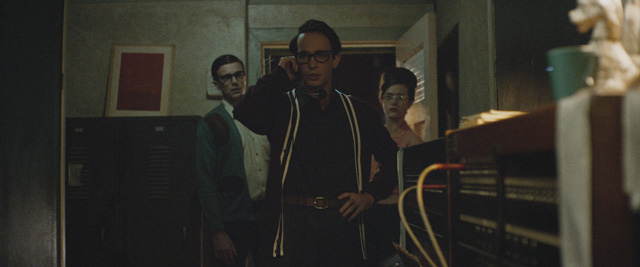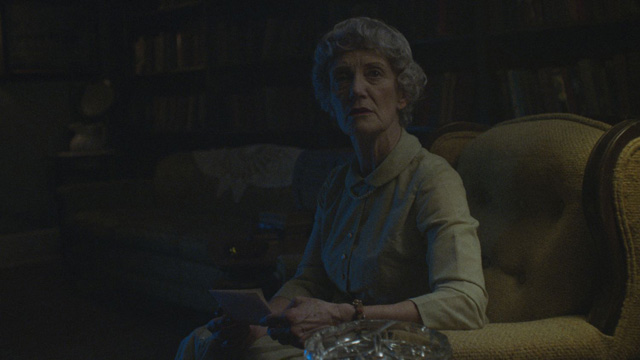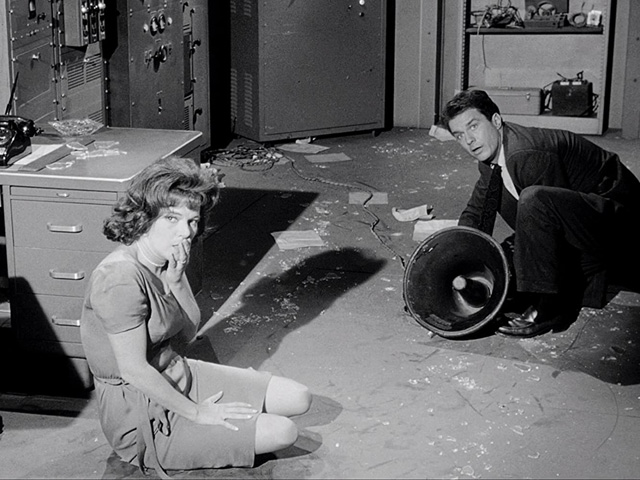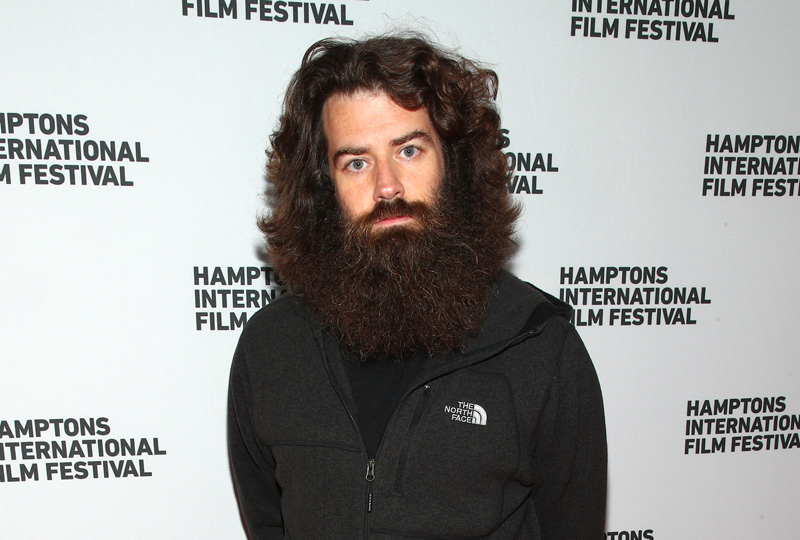Amazon Studios provided ComingSoon.net the chance to chat 1:1 with The Vast of Night director Andrew Patterson about his critically acclaimed sci-fi drama (91% on Rotten Tomatoes) now on Prime Video. Check out the full interview below!
Click here to watch The Vast of Night on Amazon Prime right now!
RELATED: The Vast of Night Review
In The Vast of Night film, in the twilight of the 1950s, on one fateful night in New Mexico, a young, winsome switchboard operator Fay and charismatic radio DJ Everett discover a strange audio frequency that could change their small town and the future forever. Dropped phone calls, AM radio signals, secret reels of tape forgotten in a library, switchboards, crossed patch lines and an anonymous phone call lead Fay and Everett on a scavenger hunt toward the unknown.
The film features former Disney Channel star Sierra McCormick (A.N.T Farm, Ramona and Beezus) as Fay, and newcomer Jake Horowitz as Everett. It will also star Gail Cronauer (Walker, Texas Ranger) as Mabel Blanche and Bruce Davis as Billy.
The Vast of Night is directed by Andrew Patterson from a screenplay written by James Montague and Craig W. Sanger. It is produced by Montague, Adam Dietrich, and Melissa Kirkendall. It had its world premiere at the 2019 Slamdance Film Festival where it won the Audience Award for Best Narrative Feature.
RELATED: CS Video: The Vast of Night Interviews With Jake Horowitz & Sierra McCormick!

ComingSoon.net: You did most of things that people making small movies should never do. You made a period movie. You did a lot of one-ers, a lot of them very ambitious Scorsese/Spielberg-level one-ers. You had a lot of special effects. And children!
Andrew Patterson: We did. Yeah, we had a 12-month old and in an actress’ arms for half of the shoot.
CS: These challenges that you set for yourself, was that part of the appeal of doing this film?
Patterson: Oh yeah. I was pretty much putting any hurdle in front of myself I could creatively in order to have something that I thought would be interesting at the end of the day. My favorite kinds of movies all do something super bold and always make a choice somewhere that nobody else would’ve made. They always find a way to do something complicated and pull it off. And so, we were aiming for that with no clue as to whether or not we were going to pull it off. When we finished it, we were like, “Okay, this is pretty good.” But the game plan was always to do bold themes that pushed the boundaries of cinematic storytelling.
CS: At the beginning of the film you dropped a “Gunsmoke” reference. I’m a big fan of old-time radio, and there were sections of the movie that feel like a radio play. There is literally a section of the film where it’s just dark and you’re just hearing the voices. So how did radio drama influence the script?
Patterson: It started with just the fact that great storytelling is great storytelling, the media is irrelevant, okay? If you pick up a great screenplay, something like “Eternal Sunshine of the Spotless Mind,” it’s a riveting read. It’s also a riveting film. And my guess is if you turned off the picture, you might still have a riveting experience just with the audio. I would guess with a movie like that, if you turned off the sound, you would still have a riveting experience with just the picture. And so, what we wanted to do was build a story that could be told in multiple mediums. Stage plays, radio dramas -particularly in the 30’s and 40’s- and the heyday before television were the biggest influences on this film. One thing I loved about that era was you have a movie like “Dark Passage” or “Key Largo” with Humphrey Bogart playing the lead, and he would do a radio version of that same movie. An hour long version. Or my favorite is probably how Orson Welles would do a movie like “The Third Man” and then after that, he would start doing individual radio half-hour long versions of that character he played.
CS: Yeah, Harry Lime.
Patterson: And that show “The lives of Harry Lime” is a prequel to the movie “The Third Man.” And they’re fun. They’re well-written. The storytelling is great. I remember getting introduced to that probably 20 years ago from the Criterion “Third Man” DVD and the radio plays of “The Third Man,” of these other stories of Harry Lime. And so, when we were writing “Vast of Night” I kind of wanted a movie that, if you turned off the picture, you would have a riveting story. For that you need dialogue. For that, you need good sound design. For that, you need really good storytelling. I wanted something that if you stripped it down and put it on a stage and had a switchboard on the left side of the stage and a radio station set on the right side of the stage and then you break and you have a quick intermission, you come back and then it’s an old age living room in the middle of the stage. I thought this would translate into something like that. And that is why this movie resembles and feels like other mediums, because I’ve always thought that great storytelling transcends its format. So we were aiming for that from the creation of it.

CS: There are sections of the film that are hyper visual, fast cuts or like, really complex camera movement, special effects, all of these things. And then there are other sections where it’s literally just a camera focused on one person doing dialogue for 10 minutes. And one doesn’t work without the other. So how did you plot it out? Did you have a board? Do you do charts?
Patterson: The script has rhythms to it. Like I knew for the first 20 or so minutes we were going to be following our characters and we weren’t going to slam in to close-ups on them. We’re chasing them, in fact, and catching up and then they get ahead of you and then you catch up and they get ahead of you. I did that because I knew that we were going to spend a lot of time locked into a room with each of them, right? And be in close-ups and the minutiae of their acting and their faces was going to carry the story. So the momentum and the speed at the beginning of the movie was built into the script. I can’t be objective about it, but people that read it said it was a page turner. Just tons of dialogue. I mean, there’s some action and misdirection, but you’re not going to read a whole lot of character walks into house and the character picks up a notebook. This script was very much centered around humans talking and telling stories. What we were hoping we’d pull off was in the rhythms of the movie, to alternate between storytelling that was still and mysterious and drew you in like a great story does anywhere around a campfire, at a dinner table, and then alternate those kind of still confessional type of stories with breakneck emotion and activity. And that rhythm back and forth has proven to work in movies and other stories, novels for forever. We were hoping we were tapped into that kind of a rhythm and beat and consistency in our approach. It works for some people, and some viewers still like having to sit and listen. And that’s fun. There are plenty of movies where you don’t have to sit and listen. So when people commit to it and they love it, I feel like those are the people we were making it for.
CS: There are some big leaps that you make, too, in terms of who you cast. Not just the leads, but Gail and Bruce. With the power of their voice and very subtle performances, they need to hold people’s attention for an extended amount of time. How did you make the leaps to pick these people?
Patterson: Well, the script was written for an 80 year old lady and a middle aged African American, both of whom take over the movie. In fact, if you start to play with just taking 15 years off of the character Mabel changes when she would’ve been born and changes some of her stories about being a little girl in Mexico. It changes the actual experience some of the things she’s said of when railroads were built and this and that. So you can’t do that. You’re locked into her character like that. You’re locked into Bruce’s character by the fact that the plot deals with minorities who were used in covert operations.
CS: Sure, like the Tuskegee Experiment.
Patterson: You got it. They were virtually built for these roles. I didn’t know Gail before the movie. She came in through an open call and just crushed the audition and pretty much had it before she walked out of the room. Bruce I’d known since a year or two before we shot this movie. He is a local city retired police officer. And he came into an open call for a commercial shoot and was great. I didn’t write the role for him, but I had him in the back of my head. If I needed somebody, I knew I had somebody for that role. The game plan was always to have a character that didn’t normally get to take over a movie get a shot to take over a movie. It doesn’t work for everybody. I know some viewers are not into this, but the only way that works is if you get an interesting story to tell or give the character something to do that you’re interested in. So we went with the former and that’s what we gave those two characters was a story that hopefully people are interested in hearing.
CS: Yeah, and you definitely lucked out with Gail in the sense that she’s not a name even as a character actor, really, but she’s worked with some heavyweight people. She worked with Altman, she worked with Richard Linklater, all those people. But if you had miscast it it would have been brutal because they’re responsible for holding so much of the audience’s attention.
Patterson: I won’t miscast. I did too much time – I think we cast this movie over about six months. I learned that that’s not the normal length of time. I learned that they want to get in there and get out in about a month maybe, or two. And if you’re really pushing a casting director, maybe three or so, or maybe I’m wrong. Maybe bigger casting directors are happy to do a six month search. In our case, I couldn’t find who I needed for the leads, Jake and Sierra -Everett and Fay- until I went and saw auditions from New York, and until I had an actress with the amount of experience that Sierra had, until I saw her read for the role. I saw some wonderful young ladies out of Texas, Oklahoma, Louisiana, Mexico. All taped, very good auditions, but you need a lot of experience to play Fay. You need years on camera. And so, I was very much a beneficiary of Sierra’s very eclectic and deep career.

CS: Sierra told me one of the reasons you cast her is because she knows how to ignore the camera.
Patterson: Yes, absolutely.
CS: You did kind of put her through the ringer. She runs more than Tom Cruise in this movie.
Patterson: With a baby. Sierra was absolutely ready to do something that would hopefully transcend her work up to that point. And I told her in advance we’re not wasting money on anything. We’re not. You guys won’t have trailers. You’ll have lovely wardrobe rooms that you can hang out in, but when we put you in a car and bring you on set, you’re going to hang out like the rest of us do, and we’ll give you a little privacy here and there. I remember one night, I don’t have chairs on set. I don’t know what that looks like. I stand or squat, right? I walk. And so, one night, she runs with that baby for hours and hours and hours, no complaining. And then she came over to me and just kind of quietly almost whispers, “Can I have a chair?” And I messaged some makeup people and was like, “Will you please bring her a chair?” And they rushed one over. I mean, and that was eight or nine hours of shoots, so very grateful for her willingness to push herself.
CS: And it’s good that you made it very clear upfront because I’ve heard horror stories from other indie filmmakers, where they’ll hire somebody and they arrive on set and the actor’s like, “Where’s my trailer? I’m not working without a trailer.” And then they wind up spending money they don’t have on a trailer.
Patterson: Yeah, we got that ironed out. I didn’t care about somebody’s credits. I just cared about whether or not the character worked. And see, you can’t get rid of that problem in advance, too.
CS: I remember years and years ago talking to David Gordon Green when he had just done “George Washington”…
Patterson: You’ve been around. You’ve been around, man.
CS: Yes. And one of the things I remember he said was, the movie was very simple. It was a bunch of kids walking around in the middle of nowhere. But David wanted it to look really good and sound really good. So they got this really expensive film stock, the kind that Terrence Malick used. And then they got the guy who sound mixed “The Matrix” to do their sound. So that’s where most of the money went into.
Patterson: Sounds familiar.
CS: So was there any one specific thing that you put your pot into?
Patterson: Yeah, I love that question. You are the only person that’s ever even come close to acknowledging sort of the black alchemy of that. The three things I got was a killer VFX house, which I’ll let the viewer figure out how we used those, a great VFX company. So that was number one. The VFX house I got were a wonderful international group of guys who are from Buenos Aires, Oner VFX.
CS: Very appropriate name for this movie.
Patterson: The next hires were my DP, which was Miguel Ioann Littin Menz, and nobody would take my call seriously, even though I was going to pay a full rate to any DP that I got. I couldn’t get any of the major agencies or any of the boutique agencies to listen to me or to take my calls. And I have many rejected emails from all sorts of DPs and cinematographers that I would’ve loved to have worked with. And simultaneously to that, this VFX house that I worked with had just finished a movie with this DP, Miguel, and it was the movie called “Hands of Stone” and it starred Robert De Niro. And I watched it and I was like, oh my gosh. This guy’s better than any of the ones I was already trying to get my hands on. And my VFX guys, Marcelo García and Rodrigo Tomasso connected us and Miguel liked the script and he agreed to come down and do our movie, even though he’d just come off a $20 million budget movie with major, major talent, Robert De Niro and so on. So those are where the things went. And then, on the back end, I made sure that the money was used to get a fantastic colorist to finish the movie. And that was a man named Raúl and he color corrected the movie so it looks like something that’s probably a bigger budget movie than it was.

CS: I wanted to dig into your influences. Obviously you wear “The Twilight Zone” on your sleeve with the name of the town (Cayuga) and with the TV bookends. The one thing this movie instantly reminded me of, even when I saw the trailer, was the very first episode of “The Outer Limits” titled “The Galaxy Being”. Was that an influence on you?
Patterson: No, I’ve never seen that. Now I’m going to maybe watch it tonight. No, I haven’t seen it.
CS: It’s literally about—I will read you the Wikipedia summary. It’s “Allan Maxwell, an engineer for a small radio station, somehow makes contact with a peaceful alien creature, who is then transported to earth.”
Patterson: Oh man. No, that was not on my radar at all, so that’s funny. I wish I could give that one credit. I mean, most influences are going to surprise people until you hear them and then they’re obvious. All of them are pretty much just straight dramas except for “Twilight Zone”, you know? So the biggest one would be “All the President’s Men”, just people picking up phones and talking. And how you can leverage what’s on the other end of that phone. And then another one would be a film like “Before Sunrise”, “Before Sunset” or any of the Linklater young people at night sort of movies. “Before Sunrise” being big, “Dazed and Confused”. That was the feeling I wanted for the first 20 or 30 minutes of the movie that sort of gets sideswiped by a sci-fi film. And then, probably the last, is something like “Zodiac”, where an anonymous caller calls in the television station and sort of holds them hostage. That was how we got the inspiration or the idea for the middle act of our movie. Probably the closest thing to the movie visually was Yann Demange’s movie “’71” from 2014. A beautiful looking movie with incredible cinematography, where you always see the spill of street lamps and shops and bars that are lit up nearby. So that was how we got a lot of the inspiration.
CS: I can definitely see the influence of “All the President’s Men” and “Zodiac” because those are two movies where you’re following these people who are forging a bond, but at the same time their obsession is driving them. They’re both movies where the end result is not the point. The point is the obsession.
Patterson: That’s a slippery slope. If you’re making stories and movies where the end result is the point and not the journey… Look, my favorite film of all time is “Lawrence of Arabia,” and the point of that movie is the journey leading to a place that is kind of pointless. So to me, I wouldn’t say that’s exactly what I was going for with “Vast of Night,” but I certainly knew that the journey was the point. And if you’re trying to make something that the last 30 seconds or four minutes of is the reason to watch it, usually those movies burn off very quickly and are not part of the discussion in cinema.
(Photo Credit: Getty Images)










